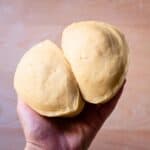Egg Pasta Dough (Perfect Every Time!)
Make egg pasta dough like an Italian nonna. This recipe turns out perfect every single time, even if you've never made homemade pasta before!
Servings: 4
Calories: 320kcal
Ingredients
- 3 eggs , preferably free range, see note 1
- 300 g flour , if the total egg weight without shell is 176 grams, see note 2
Instructions
Before you start
- Weight the eggs and note their total weight without eggshells.
- Calculate how much flour you need: egg weight in grams multiplied by 1.75
- Weight the amount of flour needed. Have a little extra flour ready on the side to use if needed.
Prepare the dough
- Sift flour and mound it on a large work surface or in a large bowl. Scoop a well in the center and add the eggs.
- Beat the eggs with a fork and start incorporating flour from the sides of the well into the egg mix, incorporating a little at a time to avoid the formation of lumps.
- Once egg mixture becomes thick enough so it doesn’t leak from the sides of the well, cover it with the remaining flour. Using a dough scraper cut it into the egg mixture until little to now dry flour is left.
- Using your hands form a dough ball pressing any loose bits of flour into the dough.
- Top Tip: Once a rough ball of dough is formed wash your hands and clean the work-surface from bits of the dough that were not incorporated. This way the dough won’t stick to the bits of the dough on my hands and worksurface.
Knead the dough
- Lightly flour your hands and work surface.
- Start kneading the dough stretching and pressing it against the work-surface and folding it over itself. Turn the dough 90” and repeat. Add a slight sprinkle of flour only if the dough sticks to your hands. As you work the dough rotating it several times it won’t stick anymore. There’s no need to knead energetically, slow and firm motions are the best. Knead the dough in this manner for about 10 minutes.The dough is ready when it is smooth and soft to touch. If you cut it half you should see small air bubbles which is a sign that the dough was kneaded to perfection.
- Form a dough ball, dust it lightly with flour, and wrap in plastic wrap or put in a ziplock bag. Let rest for 30 minutes (for up to 2 hours at room temperature or up to 8 hours in the fridge) before rolling.
Notes
- See the Step By Step Pictures for a visual walk-through of the recipe.
- Use a kitchen scale to measure all ingredients in grams.
Nutrition
Calories: 320kcal | Carbohydrates: 57g | Protein: 12g | Fat: 4g | Saturated Fat: 1g | Polyunsaturated Fat: 1g | Monounsaturated Fat: 1g | Trans Fat: 0.01g | Cholesterol: 123mg | Sodium: 48mg | Potassium: 126mg | Fiber: 2g | Sugar: 0.3g | Vitamin A: 178IU | Calcium: 30mg | Iron: 4mg
